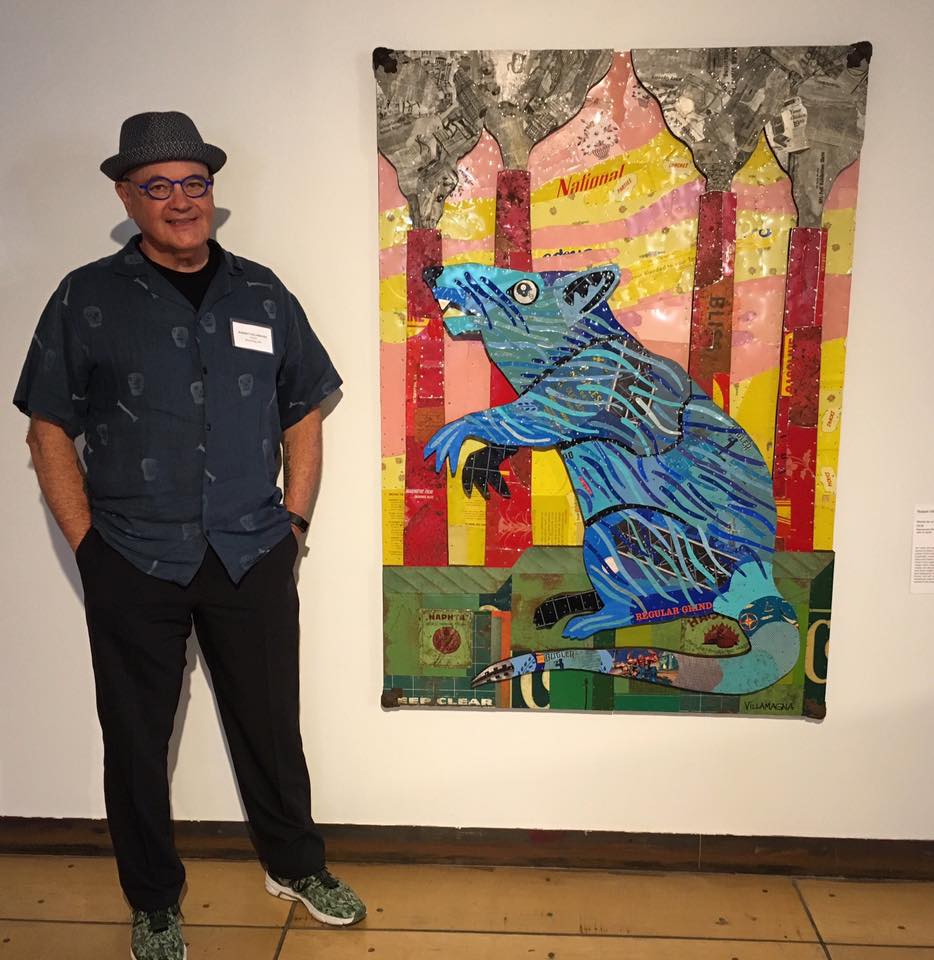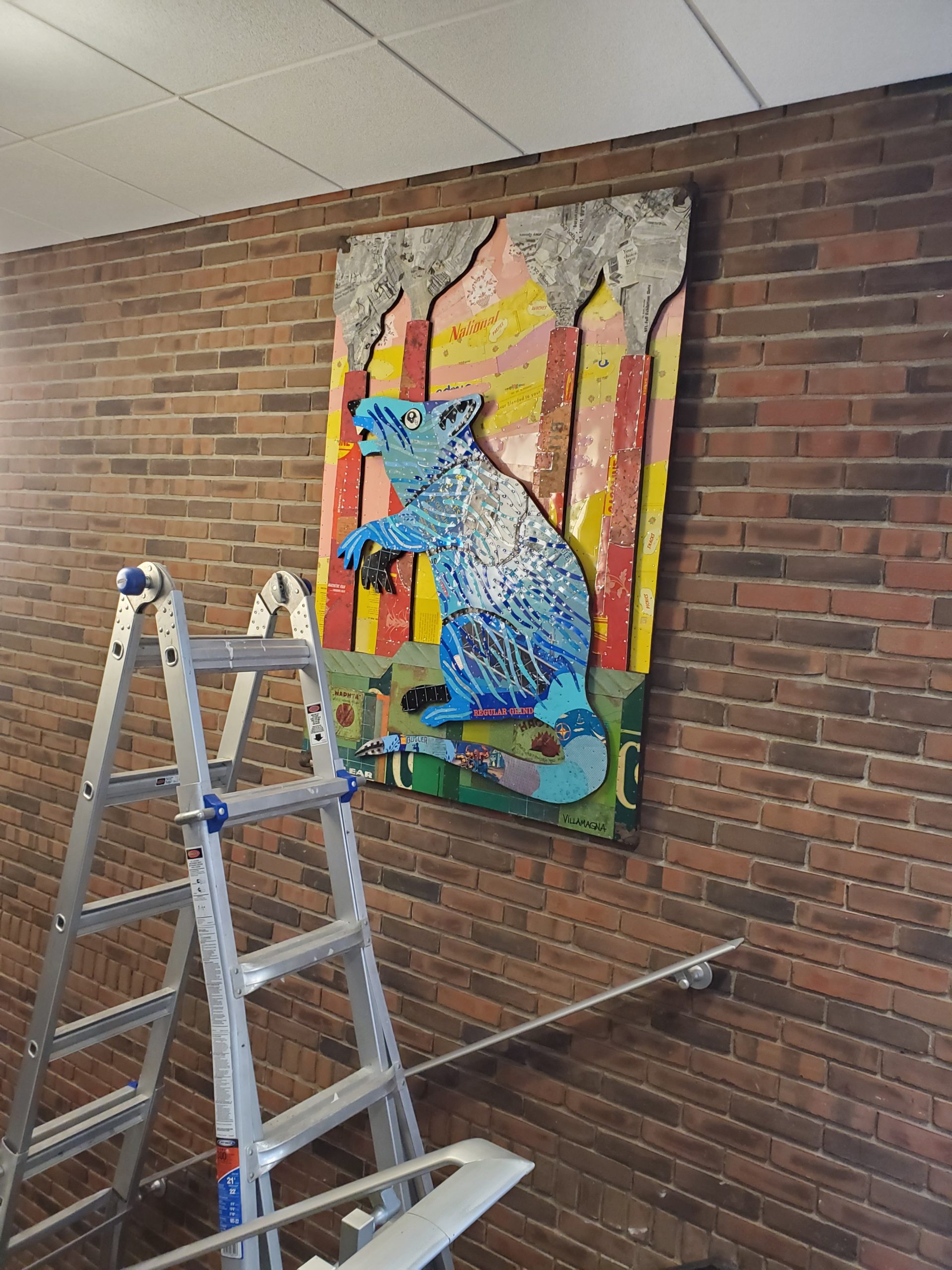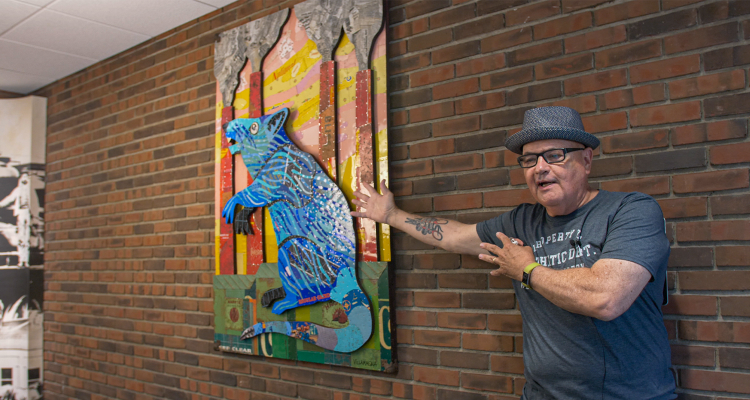Public libraries exist to provide free and equal access to resources, helping people to pursue knowledge and inspiration. And “Shrine for a Mill Rat,” the new permanent exhibit (courtesy artist Robert Villamagna), recently installed at the Ohio County Public Library in Wheeling, epitomizes that mission.
I’ve been a fan of Bob Villamagna’s art since I became aware of it. He breathes new life and soul into reclaimed metal pieces, advertising art, cabinet cards and other flea market finds, assembling stunningly colorful collages full of whimsy, that are simultaneously familiar, yet completely reinterpreted. So when I saw Bob’s Facebook post back in January, saying that he wanted to find a home for a huge piece of art taking up too much space in his studio and to “give this work to a public indoor space that is accessible at least six days a week,” I jumped at the chance to throw the library’s hat in the ring, even though the primary subject was a big blue rat. And Bob chose us!
Unfortunately, of course, shortly after the decision was made, the COVID-19 pandemic struck, delaying our plans. But now we are pleased to announce that, after some herculean efforts by my colleague Erin — given the Mill Rat’s daunting size and weight (62 inches by 48 inches by 3 inches of repurposed lithographed metal and nails on wood panels, weighing 100 pounds) — “Shrine for a Mill Rat” is now installed near the 16th Street entrance to the library.
On June 9, Bob delivered a Lunch With Books Livestream program from the Mill Rat’s new home, telling the work’s origin story and sharing the inspirational message behind the art that makes it so appropriate for a public library located in an old steel-making town.
[template_part type="video" title="Shrine for a Mill Rat" description="Bob Villamagna introduces his art installation at the library." url="https://youtu.be/NPCPnTX1kQ8"]I had the opportunity to talk with Bob after the event. Here’s my interview with the artist:
How/why did you become a visual artist?
I grew up in the Ohio River rustbelt. I was 5 years old when we visited the Carnegie Museum in Pittsburgh. We did not view the art galleries, but rather focused on the Natural History Museum. For some reason, the displays of knights in armor had a huge impact on me. We went to my grandparents’ house later that day, and I began drawing my versions of those knights using pencil on scrap paper. My dad said, “Those look just like what we saw today!” I believe his response planted a seed, and so, from the time I was a preschooler, I have had a mark-making tool in my hand.
However, the rustbelt, in general, is not a supportive environment for one who wishes to make art his life’s work. Growing up, almost every adult male in our neighborhood was a steelworker or a miner. I ended up working in the steel mill myself for 13 years. The themes or narratives found in my work come from my own life experiences, as well as stories that the found objects themselves may suggest.
Why did you choose the style you prefer — West Virginia Tinman?
In the 1980s, I focused on water media. At that time my subject matter was old gas stations, mom and pop grocery stores, Mail Pouch barns and rusty machinery. In mid-’82, I entered my watercolors in the Three Rivers Arts Festival artist market, and I was rejected. I decided I needed to become a kick-ass watercolorist, or find a new media.
About this time, I found a book at a used bookstore titled The Art of Assemblage. It was about artists who make work from found objects, or “junk,” instead of traditional art materials. I was hooked! I loved junk, and to think that artists used this stuff to make their work, well, my mind was blown!
The next year, my new assemblage work got me into Three Rivers. I gradually pulled away from doing watercolors.
I was creating assemblages (found object art) for about 10 years. One day, [my wife] Chris and I were in Border’s Books in Pittsburgh. She spotted a book titled The Fine Art of the Tin Can by Bobby Hansson. She said “You might be interested in this!” And of course, I was! (You may see a pattern here: books change lives.) I started using repurposed lithographed metal, or “tin,” in my work. Sometimes I use the tin alone; other times with found materials and various art media.
I am very passionate about working with tin and found materials, especially those items that show use, wear and rust. I love stuff with character. I often find myself wondering about the person who made these materials, who used them, who held them. I like to think that a part or energy of that person is still contained in these things, and now it’s transferred into the artwork. I’m giving that discarded piece of metal, or that old object, a new life, a different life. I am thrilled that I can use this stuff and that it becomes a part of my creative process. These various materials are every bit as much of my palette as is a tray of oils are for a painter. For me, walking through a flea market is like walking through a well-stocked art materials store. The flea market is my palette.

Did other artists inspire you? Yeah, I know. Which ones?
The first artist to “inspire” me was Jon Gnagy, host of Learn to Draw, a syndicated television series of 15-minute drawing lessons. Watching Jon create his images each Saturday morning was simply magical for me. The first time I watched him create the shadow of a tree stump on snow and it blew my mind!
As a teenager, my art heroes were Norman Rockwell (thanks to my parent’s subscription to the Saturday Evening Post) as well as cartoonist John Johns and watercolorist/illustrator Nat Youngblood (both artists did work for the Pittsburgh Press, which came to our house on Sundays). Into my late teens, I became crazy about the work of Ed “Big Daddy” Roth, Stanley Mouse and Rick Griffen. I was airbrushing T-shirts back then. Into my adulthood, my heroes become this weird mix of Julian Schnabel, Joseph Cornell and Edward Hopper.
What’s the best thing about being an artist? The worst thing?
The best thing is the freedom and ability to create something that did not exist before. I love that! I don’t even know where it comes from sometimes, but I love making stuff!
The worst thing. That would have to be that it doesn’t pay well, especially in the beginning. Don’t expect to get rich. If you want to make money, I suggest you become a lawyer or go to medical school. I’m not saying there are not artists who do well for themselves, but it’s rare. The primary reason for being an artist is because you have a fire in your belly, and the only way to control that fire is to make stuff. It’s a curse in a way.
Tell the story of “Mill Rat.” Why does it exist? What inspired it? What does it mean to you? What happened with it — exhibits, awards, feedback, commentary? Why did you choose the library for the place to display Mill Rat? Is there a connection to what public library’s represent?
“Shrine for a Mill Rat” was created for Transformation 10: Contemporary Works in Found Materials, The Elizabeth R. Raphael Founder’s Prize Exhibition. The work was required to show “transformation.” As I work with repurposed metal, there is this period of chaos during the creating process where I think that nothing good is going to come about. Eventually, however, a transformation takes place, and these bits and pieces of lithographed metal come together to form a totally new image. Upon close inspection of my work, the viewer can discover the history of the material and some insight into its former life. My piece also represents the transformation of myself, a former “mill rat,” a derogatory term that was sometimes used to label those of us who worked in the steel mill.
The exhibition featured 26 national and international artists who had been selected as finalists for the 2017 Elizabeth R. Raphael Founder’s Prize. Transformation 10, which ran from Sept. 14, 2018, to March 23, 2019, showcased newly created, innovative artworks that incorporated found materials in unexpected ways and challenged notions about commonplace objects, found materials, and contemporary art for personal and global narratives, expressions and aesthetics.
Originally planned as a two-year traveling exhibition, the plan was canceled, and the works were returned to the artists in the summer of 2019. I found myself with a large, nearly 100-pound artwork back in my small studio. After attempting to work around it for several months, I decided to go on Facebook and offer the work free to a public space. I was contacted by representatives of three possible venues. After meeting with Seán Duffy of the Ohio County Public Library, I realized it was the best fit.

How does this piece rank for you personally in your portfolio (pantheon) of work?
It ranks high! I say that for two reasons. One, it was part of a high quality exhibition that included some amazing artists from all over the world. Two, it connects to me personally and my time in the steel mill.
What do you hope happens with this “permanent” exhibit?
I’m just happy that it will have an audience. Like most artists, we hope that our art gets “seen.” Maybe kids will see it, and hopefully, they will want to know what it’s all about, why did the artist make it, what’s the story. Maybe it will inspire a young person to make his own art. That would be so great!
Finally, the most critical point: Please tell us about Mill Rat’s magnificent eye and how it is by far his most important and beautiful feature.
I was about to cut out some black tin and add a white highlight in order to create the pupil, and then I remembered this Steeler logo on a piece of scrap metal. I was able to find it and, lucky for me, it fit perfect! Plus, there was this “steel” connection! Sometimes things just work!
Ok, I lied. One more. What about the other parts? What do they mean? Decode this rat for us.
When I was working in the mill, I mentioned to a coworker that I wanted to get out. His response was, “You’re a mill rat, and you’ll always be a mill rat!” That stuck with me, and if you “decoded” the rat, this is the story you would find.
Visiting the Mill Rat
You will be able to visit “Shrine for a Mill Rat” just as soon as the Ohio County Public Library is once again open to the public during regular business hours at his new home in the stairwell at the right of the 16th Street entrance. Meanwhile, until the COVID-19 threat passes, you can still see Mill Rat by peeking through the library window or perusing the library’s image gallery.
To see more of Bob Villamagna’s work, visit his website or his Facebook page.
• Seán Patrick Duffy is the adult programming coordinator at the Ohio County Public Library and the executive director of the Wheeling Academy of Law and Science (WALS) Foundation at the First State Capitol in Wheeling. He earned a bachelor’s degree in history and an MBA from Wheeling Jesuit University and a JD from the Washington College of Law at the American University. He is the author or editor of four books and numerous articles on local history and the editor of the Upper Ohio Valley Historical Review. One of the founders of ArchivingWheeling.org, Duffy is vice president of the West Virginia Independence Hall Foundation Board.


